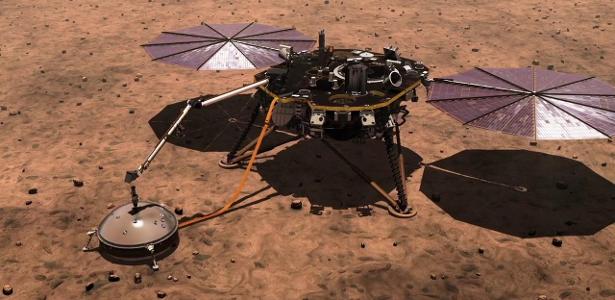After recording “marsquake”, the InSight probe prepares to die
3 min read

The InSight Mars Lander probe, in Mars Since 2018, he is at the end of his life: in a few months, he should stop, due to a lack of energy. But even on its dying breath, it continues to provide valuable insights into the geological and seismic processes on the Red Planet. The NASA They talked more about the discoveries and the future of the expedition, in a live broadcast Tuesday afternoon (17).
The team estimates that the probe, now covered in orange Martian dust, should continue to conduct science operations until mid-July, gradually shutting down all activities by the end of this year. Even his robotic arm will be put into “retirement mode”.
“One of the legacy of InSight is that it really demonstrates the use of seismology technology for planetary science,” said Bruce Banerdt, principal investigator on the project at NASA’s Jet Propulsion Laboratory (JPL). “We have been able to map the interior of Mars for the first time in history.”
hammers
On May 4, InSight detected a ‘quake-quake’ of magnitude 5 – the equivalent of the average earthquake here on Earth, but the largest ever recorded on another planet. “We have been waiting for the ‘big’,” Bannerdt said. “It will definitely provide a view of the planet like no other. Scientists will analyze this data to learn new things about Mars for years to come.”
The probe landed on Mars in November 2018, equipped with a highly sensitive seismometer, to study the structure and activities emanating from the planet’s interior. More than 1,300 tremors have since been detected. The old record for a magnitude 4.2 earthquake – about ten times weaker – was set in August 2021.
But these discoveries have a price: After three and a half years in such a barren and hostile place, there is a lot of dust accumulating in the solar photovoltaic panels, which generate the power to run them. Unlike the Perseverance and Curiosity sensors, which are roving vehicles (robots with wheels that move across a surface), InSight is a (fixed) landing craft.
Without movement, catching less and less sunlight, it is humiliating. Initially, InSight ran about 5,000 watt-hours per “sun” (a day on Mars). Today, that number has dropped to about 500 watts. Project manager Cathia Zamora Garcia gave an example: It’s a reduction equivalent to a grounded electric oven from 1 hour 40 minutes running to just 10 minutes.
The JPL team was able to improve the situation a little with a risky maneuver: picking up a handful of Martian soil with its arm and throwing it into the dust. This has been successfully implemented six times, according to Cathia Zamora Garcia, deputy project manager at InSight.
But the boards could only be cleaned marginally – the shutdown is still irreversible, unless a miracle happens, like a very strong wind. Likewise, a dust storm can predict the fatal fate of the lander.
legacy
Even with this result, already predicted, the mission was a success, exceeding NASA’s expectations and producing several published studies.
Studies of this kind are essential to understanding the structure and evolution of rocky planets such as Earth, Mars, and Venus. Mars does not have plate tectonics like Earth, so events occur in the mantle – the molten region under the crust. Seismographs can also record movements caused by impacts.
InSight has given us our best view of the red planet’s geological and seismic systems: it revealed crustal thickness and composition, mantle and core details. And there is a huge volume of data for scientists to analyze, using the secrets of Mars, for many years after their “death”.

“Entrepreneur. Music enthusiast. Lifelong communicator. General coffee aficionado. Internet scholar.”


:strip_icc()/s04.video.glbimg.com/x720/11792055.jpg)

:strip_icc()/s03.video.glbimg.com/x720/11786998.jpg)